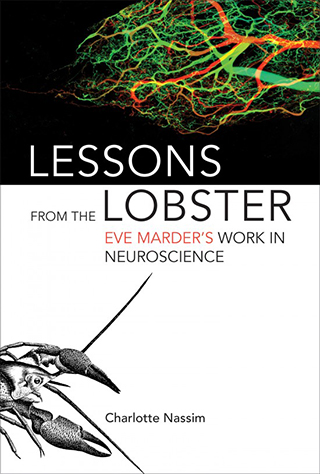Neuroscientist Eve Marder’s research chronicled in a new book
Read an excerpt to discover how the eminent scientist achieved her insights into the human brain by studying neurons on the stomach of lobsters.

A new book, "Lessons from the Lobster: Eve Marder's Work in Neuroscience (MIT Press)" by the London-based independent scholar and writer Charlotte Nassim, tells the story of the Brandeis professor's quest to understand how all neurons, including those in the human brain, function.
Marder '69, the Victor and Gwendolyn Beinfield Professor of Neuroscience, is a member of the National Academy of Sciences and the recipient of the 2016 Kavli Award in Neuroscience and served as the president of the Society for Neuroscience in 2008.
"One of the conclusions that readers of Charlotte Nassim's 'Lessons from the Lobster' should take from the book is that laboratories are communities of scholars of all ages," Marder wrote recently on the Science at Brandeis blog. "Lifelong friendships are often formed and sustained as laboratory colleagues may spend as much time together as they do with other friends and family."
Below is an excerpt from the book.
The core of my project is Eve Marder's work, which reveals the outstandingly original scientific mind and the distinctive approach, as intuitive as it is analytic, that define her thinking. A key characteristic of this approach is her mistrust of the hypothesis-driven research that has long been established as scientific method. It expects researchers to form a hypothesis and then design the experiments that might prove or disprove it. Marder prefers to “let the data speak, let the data drive the questions.”
Marder's research results over the years are both detailed and broadly significant, but no one result has revealed a Higgs boson of neuroscience and no one result labels her. What she has done is to marshal her masses of data into a big frame. Every scrap of information, expected, unexpected, or enigmatic, is a pointer for her, a shiver of the needle on nature's compass. Her discoveries are of fundamental truths in biology, statements of unsuspected basic concepts that have been revealed as much by her creative thinking as by her laboratory's findings.
After her earliest research on the characteristics of the stomatogastric ganglion, its neurotransmitters and connectivity, Marder pioneered the studies that introduced neuromodulation. This term applies to the way the responsiveness of neurons can be altered by chemical substances reaching them, not through synaptic contacts with other neurons, but by other pathways. The neuronal circuits of the stomatogastric ganglion produce rhythmical patterns of activation and Marder has shown that functional sub-circuits of neurons can be formed or disbanded by the action of such neuromodulators.

In 1993, she initiated the development in her lab of the 'dynamic clamp', a breakthrough in electrophysiological methods, now used in labs all over the world. It allows researchers to observe real biological neurons responding to inputs calculated by a computer using feedback from the neurons' responses.
Her lab has led the way in analyzing the characteristics of neuronal circuits, showing how they operate under a wide range of conditions affecting each of their neurons while keeping the networks robust and reliable throughout the lifetime of the animal. Marder recognized that individual animals of the same species may find different ways of running their circuits to provide similar output, multiple solutions as they came to be called.
Marder's lab is now recognized as a leader in computational neuroscience and is currently using both theoretical and experimental research to analyze the closely linked concepts of neuronal homeostasis, animal-to-animal variability, multiple solutions and compensatory mechanisms. Marder has formulated coherent theories of these phenomena; the findings apply equally to the neuronal circuits of vertebrate animals, although for many years this was disputed.
I regret that I have had to be ruthlessly selective in telling Marder's science story; her long list of publications contains a wealth of fascinating and significant material that I wish I could have included. Alas, I am offering readers something like a ‘best-of’ compilation disc. But then there is the question: is the best yet to come? This book has been years in the making, and there is no obvious finishing line. Both Marder and I now recognize that not only has neuroscience made enormous progress during those years, but Marder herself has advanced in accomplishment and in status, her lab has thrived, her perspective on the past has evolved, her goals for the future have changed.
Eve Marder is now in her late sixties, a friendly woman who naturally attracts affection and esteem and is renowned for her mentoring of younger scientists. She goes to the lab every morning, arriving around 10 o’clock. Her office door is always open to the lab and researchers go in and out all day, with questions and problems, new data and new ideas. Marder encourages this traffic, baiting her room with chocolate and biscuits to entice the team to bring her the most recent data from experiments. She says she loves data, gets 'grumpy' if the results don’t flow in, and can't understand people who don’t want to scrutinize them immediately.
Two sides of Marder's office are lined with shelves holding orderly stacks of books and reprints of her published papers. Opposite them, her L-shaped working space is covered in a disorder of papers, journals, data printouts and notes that transcends the word 'untidy'. A wide-screen computer emerges from the chaos under a life-size cut-out of Xena, Warrior Princess, scowling into the room. In contrast, her apartment on Boston Harbor, with its picture windows overlooking the water, is tidy and well organized.
I once asked her how she gets so much done yet stays so relaxed. She said it's because she reads very quickly and can write a thousand words in a couple of hours. She added that she doesn't agonize over perfection, partly because she gets bored easily. So how did she get through the years of repetitious experimental procedures, I asked. “Well, it’s like craft, like needlepoint.” Marder’s apartment is adorned with gorgeous needlepoint cushions and skeins of wool in mouth-watering colors are wound on a rack in a corner of her bedroom. She is famous for her love of color; her dazzling shoes are legendary and there are a dozen pens with different colored inks on her desk.
At any one time in the years I've known Marder, she has been juggling the demands of her lab with those of the university Biology Department, her teaching semester, the editorial boards of journals like Current Biology and the Proceedings of the National Academy of Sciences, writing articles, myriad invitations to speak, and the time given to various committees and advisory panels. In 2008, Marder was President of the Society for Neuroscience and she is also well known in the wider scientific community. She is a member of the National Academy of Sciences Council and a Deputy Editor of eLife.
No one was surprised when, in 2013, this influential scientist was one of the fifteen neuroscientists brought together to advise President Obama’s B.R.A.I.N. (Brain Research through Advancing Innovative Neurotechnologies) Initiative at its inception. She is now a member-at-large of the Multi-Council Working Group that oversees the long-term scientific vision of the initiative in the evolving neuroscience landscape. Curiously, however bold and forward-looking that vision may be, it actually obliges Marder to look backwards. The B.R.A.I.N. Initiative aims to “map the circuits of the [human] brain, measure the fluctuating patterns of electrical and chemical activity flowing within those circuits, and understand how their interplay creates our unique cognitive and behavioral capabilities…” If you delete the words ‘brain’ and ‘cognitive’ from this statement, it describes what research on the stomatogastric ganglion in lobsters and crabs has already achieved.
A circuit map, or ‘wiring diagram', shows the basic anatomical framework within which each neuron is active. It shows what cells communicate with what others, but doesn’t show much about the signal passed between them – only whether it is excitatory or inhibitory, electrical or chemical. It’s a case of knowing who is talking to whom, but not hearing what they’re saying. As Marder says, this sort of diagram “is absolutely necessary and completely insufficient”. Her work, eavesdropping on those conversations, has revealed the organizing secrets of neuronal networks. Now the same information must be gleaned from groups of millions of human neurons, but starting this time from some basic, accepted rules, and knowing that patterns similar to those found in simpler animals are likely to hold good.
One question about Marder, about those forty years, that will probably occur to my readers, is whether her work is the product of a particular time. This idea would in no way detract from her flair and brilliance, but was she, perhaps, absolutely suited to that era? Has the march of technology, which now promises to bring within reach the study of large numbers of neurons, overtaken her work? I think not; Marder has always embraced any discipline or new technique that can help to answer her questions and her ability to examine data whilst putting it into useful perspective and relating it to wider issues is exceptional. She views the arrival of ‘big data neuroscience’ with an enthusiasm tempered only by her recognition of the need for sound biological intuition in exploiting it. She has certainly not run out of questions; her work is in full swing and many alumni of her lab continue to add to the story from their own labs. As one of her former post-doctoral researchers told me: "There's no doubt about it – we will all work on Eve’s questions for the rest of our careers."
Categories: Research, Science and Technology





